|

• • • • • • • • • • • •
|
 |
|
A wireless lease buyout that would
make any agent blush with envy
December 3, 2012 - If a Lee County, Fla. property owner was adept at reading micro expressions, he might have questioned a momentary Mona Lisa smile from the Crown Castle International's representative as a deal was inked for $1 million for property valued at $620,000 by the county's tax appraiser.
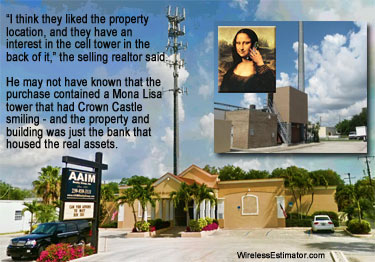 The November 6 sale might have also sparked a fleeting grin from the seller after he unloaded a commercial parcel in a county that has seen property values in a free-fall for the past six years with 2008 having a drop of over 25%. The November 6 sale might have also sparked a fleeting grin from the seller after he unloaded a commercial parcel in a county that has seen property values in a free-fall for the past six years with 2008 having a drop of over 25%.
But it was clearly Crown Castle that walked away with an agreement that would make any agent beam for years to come.
Peninsula Associates LLP knew that a 150-foot monopole directly to the rear of their 7,855-square-foot office building was an additional asset since it was providing revenue of $5,500 a month.
What they might not have known is the true value of the six-tenant monopole used by all of the major carriers.
Peninsula's listing agent, Kevin Fitzgerald of NAI Southwest Florida, according to Gulf Coast Business Review, said, “I think they liked the property location, and they have an interest in the cell tower in the back of it.”
Interest? Perhaps an overwhelming desire to maintain the lease of one of their most profitable sites in Southwest Fla. might be more apropos since the underlying property and commercial building is just the bank that houses the real assets.
Location, location, location - ah, one more - location
The site serves medical facilities, shopping malls, tightly packed residential communities, a college and an international airport less than a mile away from the 1421 Colonial Blvd. monopole built in 1998.
It is the main site that provides coverage along Colonial Blvd. to the east and over the Midpoint Bridge linking Fort Myers and Cape Coral.
Add another huge plus to its location.
According to Ken Schmidt, President of Steel in the Air, Inc., a company that provides guidance to landowners regarding cell tower lease related issues, there are between 45,000 and 50,000 cars that pass by the tower daily.
Although it's not often that towercos will purchase an entire parcel, Schmidt can see why Crown Castle did in order to get the much better end of the deal.
"Even assuming that Crown strips the tower lease from the parcel and resells it at a 25 percent reduction on Lee County’s just value, or $465,000, that means that Crown purchased their future rent obligations at $535,000 or a little over eight years’ worth of rent. Unfortunately, it appears that the landowner may have left a good deal of money on the table here because they didn’t understand what they had," Schmidt said.
Although there are no publically available standard valuation benchmarks due to tenant, structure and existing lease variables such as annual escalation fees and the remaining term, the Crown Castle Mona Lisa - if sales multiples for that structure were at 15 times annual rent - might have been closer to $1 million just for the lease buyout.
A collective mood of seller's and realtor's remorse might be reasonable.
|
|
U.S. site acquisition folks would love to have nirvana-like rules of their northern neighbor
October 26, 2012 - When Crown Castle purchased T-Mobile's 7,180 towers earlier this month the cost was approximately $334,000 for each tower. In California, most of the monopoles were less than 50 feet tall. However, since some of the structures are older towers in hard to procure areas which were built for PacBell, the price - to some 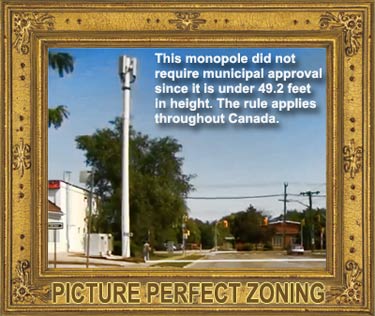 -seemed equitable. -seemed equitable.
But if you drive from Seattle's corporate digs for T-Mobile to Vancouver, Canada, you could easily buy a single tenant monopole for less than one third the price - that's if you didn't want to negotiate.
One of the primary reasons for the reduced cell site cost is because in Vancouver you don't have to get permission from local authorities if the structure is less than 49.2 feet in height. Nor do you have to get permission anywhere else in the close to 4-million square-mile country.
Industry Canada regulates tower siting and they set the height rule because "towers less than 15 meters generally have minimal local impact," a statement that Seattle zoning officials would surely disagree with.
However, Canadians and legislators are becoming increasingly concerned by carriers such as Telus, Rogers, and Bell having almost unfettered access to where they want to build a site. A number of structures are within 50 feet of children's bedrooms.
The less-than 15 meter sites are typically rubber stamped by Industry Canada. The federal regulator received $600 million in application fees from carriers expanding their network in the past year.
A spokesperson for Industry Canada informed Wireless Estimator that they neither track 15 meter towers erected across Canada, nor any other structures that are permitted and built.
Even taller structures are easier to permit in Canada. If, however, a municipality denies an application for a tower, unlike in the U.S. where the dispute enters the judicial system, the carrier pleads its case to Industry Canada and it is quickly resolved, most oftentimes, based upon press reports, in the applicant's favor.
Many rulings against communities were because a major factor in the denial was due to perceived health concerns.
In one of their rulings, Industry Canada said, "Our analysis has confirmed that the proposed installation will be in full compliance with Health Canada's Safety Code."
Canada provides for a 120-day shot clock for new tower sites. The U.S.'s time frame is 150 days.
Anyone seeking to build a tower 49.2 feet or more in height must contact the local land-use authority. If the municipality does not have any procedures in place, and many of them do not, then Industry Canada's procedures must be followed. This can include written notification to residents and groups within a radius of three times the height of the proposed structure.
According to their regulations, notification would not have to be made to landowners if a 90-foot tower was to be erected in acreage that was more than 270 feet from a resident's property.
However, if the tower is 98.4 feet or more in height, the developer must place a notice in a local community newspaper.
A tower can be excluded from an environmental assessment, if it's not being built in a national park, park preserve, national historic site or historic canal, if the structure's foundation is less than 82 square feet.
Therefore, realistically, a 1,000-foot guyed tower could be erected without an EA since the 82-square-foot threshold is not a sum of all foundations, but for each individual anchor.
The definition would also allow a self supporting tower of 500 feet or more to be permitted in a picturesque vista without an environmental assessment.
|
|
Community's arousal regarding giant phallus
gets T-Mobile to re-skirt
August 28, 2012 - Head across the bay from Castro Valley, Calif. to San Francisco and you'll visit a city that proudly celebrates sex with parades of debauchery and a 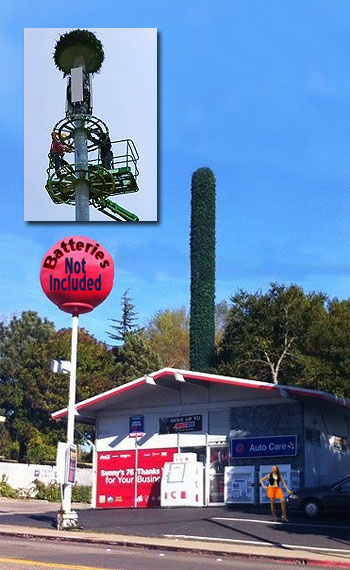 proliferation of businesses such as the Antique Vibrator Museum. proliferation of businesses such as the Antique Vibrator Museum.
Castro Valley's residents don't want their community of 60,000 people to become like San Francisco's Castro district where there is an unabated increase of adult novelty shops.
So much so that some Castro Valley homeowners put pressure upon the Alameda County planning department, which oversees the unincorporated town, to have T-Mobile re-skirt their Lake Chabot Rd. cell tower because it looked too phallic.
According to company spokesman Rod De La Rosa, the carrier intended it to resemble an Italian cypress.
However, some irate citizens said that they thought it looked more like an Italian stallion, or a vibrator.
County planner Sonia Urzua demurely tiptoed around what the 60-foot-tall faux perennial pole reminded her of, stating, "It was supposed to look like a tree, and, well, there's no delicate way to describe what it really does look like."
For the past six months since it was erected, young girls would come by, point at it and laugh, said a mechanic at the 76 gas station next to the tower.
He said that a number of people would pull up to it and take pictures. The tower is also next to an elementary school and a church.
The planning department ordered T-Mobile to alter the tower so it would look more like a tree, and De La Rosa said that they wanted to be good neighbors so they would be happy to add different branches, according to the San Francisco Chronicle.
A tower crew began adding the new branches this week to make it look more like a slightly triangulated cypress tree and less like a giant phallus.
Also this week, the San Francisco Public Library began installing privacy screens on computer terminals inside its main Civic Center branch so that patrons can watch porn without being observed.
But passersby in the library will know what those folks are viewing and enjoying by their bulging eyeballs, such as when Castro Valley residents are caught spending too much time staring at the newly trimmed columnar-like conifer.
|
|
Connecticut legislation will require towercos
to minimize aesthetic impact
May 16, 2012 - Legislation has passed both house of Connecticut's General Assembly that will increase municipal oversight during location requests for communications towers. The bill (H.B. 5271) now awaits Governor Dannel Malloy's 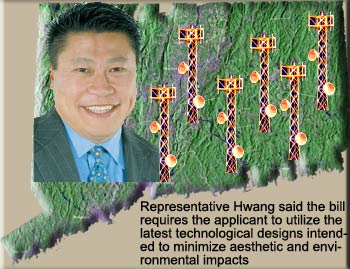 signature. signature.
State Representative Tony Hwang, who co-sponsored the legislation, says the bill makes significant improvements to the law, and will give impacted towns a stronger voice in process of locating telecommunication cell towers.
"Current law does not require the Siting Council to take into consideration a number of issues which are a significant concern to host communities and residents who are located next to proposed cell tower sights and the height restrictions for the community. This bill will require that some of these concerns be taken into consideration," said Hwang.
The bill requires applicants to work with host municipalities in the pre-application process, and extends the municipality consultation process from 60 days to 90 days, according to Hwang. It also requires the applicant to utilize the latest technological designs intended to minimize aesthetic and environmental impacts.
In addition, it prohibits the placement of towers within 250 feet of a school or commercial day care center unless the location is acceptable to the town's chief elected official or the Siting Council finds that the facility will not have a substantial adverse effect on the aesthetics of the area.
The bill also permits the municipality to initiate civil action against any party that intentionally omits or misrepresents facts in the process.
|
|
Michigan co-location bill being attacked,
especially the community's review fee
April 23, 2012 - Michigan's Senate Economic Development committee has approved a bill that pre-empts local zoning when it comes to the co-location of wireless communications equipment on existing towers.
The bill, SB 1064, was approved in just over 24 hours after its introduction and now heads for the Senate floor.
Co-locations will not be reviewed  by municipalities for compliance if: by municipalities for compliance if:
- They do not increase the overall height of the support structure by more than 10% of its original height.
- They do not increase the width of the structure by more than the minimum necessary to permit co-location.
- They do not increase the area of the existing compound to greater than 2,500 square feet.
The Michigan Municipal League strongly opposes the legislation. Amongst other areas of concern, they believe that the definition of "original height" needs to be better defined.
"We don't want to see a community have to fight because a company wanted to collocate on a tower and argue that the 10% increase is based on the current height of the tower which may have already been increased by 10% if there have been previous collocations under this bill," said Andy Schor, Assistant Director of State Affairs.
The legislation also caps the fees charged to co-locators at $250. Schor says that the small fee preempts local control and many municipalities would have to subsidize the review of wireless telecom equipment.
He also said it might prevent communities from hiring a consultant to review an application because the $250 cost would not cover their charges.
Rodney Nanney, a Michigan building and zoning consultant, said the legislation would impose a one-size-fits-all mandate on local governments where cell tower co-location is concerned. "This is a solution in search of a problem," said Nanney.
"Please contact your state senators today and tell them to oppose this bill as unnecessary and a slap in the face to local governments, most of which have addressed the issues surrounding cell towers in ways that best fit their community," said Nanney.
|
|
Carolina town polices monopine branch totals
March 9, 2012 - American Tower Corporation received a dressing down on Tuesday from the Oak Ridge, North Carolina Town Council for not providing their expected skirt of branches on a recently constructed monopine, and town officials voted to move forward with enforcement procedures.
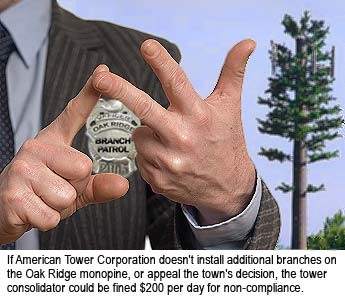 According to Mayor Ray Combs, the constructed tower differs considerably from the site plan the council approved one year ago. According to Mayor Ray Combs, the constructed tower differs considerably from the site plan the council approved one year ago.
Town Manager Bruce Oakley said that currently the branches are just at the top and the council expected to have approximately 70 percent coverage so that tower's branches fell below the tree line.
Town Attorney Michael Thomas had previously asked American Tower to provide a plan that would bring the cell tower into compliance and the town council received ATC's plan six days before its meeting.
However, Councilman Spencer Sullivan said he felt that the recently submitted plans did not provide enough information to establish any confidence that ATC would do what they verbally claimed they would.
Oakley said that Guilford County has been informed of the case and will conduct a brief investigation before issuing a zoning violation. ATC and the property owner will then be notified and given 15 days to appeal it to the town’s Board of Adjustment or 30 days to correct it.
If not appealed or corrected in 30 days, a second 30-day notice would be given. At that point, according to Oakley, civil penalties that could reach $200 per day would begin.
|
|
New Jersey streamlines its collocation process
January 17, 2012 - New Jersey legislation to simplify the zoning process for collocations was vetoed by Governor Chris Christie on January 9 because he said the 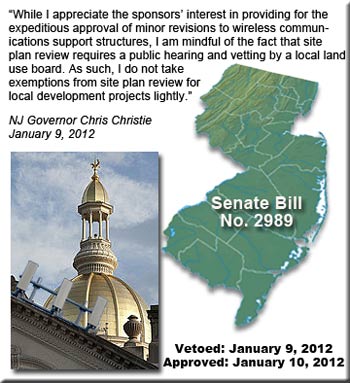 bill's provisions did not explicitly retain the requirement for site plan review when a proposed collocation would result in a deviation from local zoning standards. bill's provisions did not explicitly retain the requirement for site plan review when a proposed collocation would result in a deviation from local zoning standards.
However, Senators Richard Codey and Jeff Van Drew, the legislation's authors, amended the bill the following day and Governor Christie signed it into law.
The New Jersey Wireless Association and PCIA - The Wireless Infrastructure Association were instrumental in getting the senators to sponsor the bill and were consulted regarding the governor's addition to the bill.
The bill waives the notice and public hearing requirements and site plan review if a collocation does not increase the support structure’s height by more than 10% or expand the square footage of any existing equipment compound beyond 2,500 square feet.
In a prepared statement, Michael Fitch, president and CEO of PCIA said, "PCIA applauds the New Jersey legislature for recognizing the importance of leveraging existing wireless infrastructure to expand and enhance wireless broadband services to consumers, businesses and public safety agencies."
The New Jersey State League of Municipalities fought against the bill, cautioning that the legislation unnecessarily impedes on local discretion and unjustifiably waives notice and public hearing requirements. "A-3949/S-2989, would exempt the collocation from any site plan review, even if it proposed increasing the height of the tower by 10% and increased the footprint of the mechanical equipment compound by up to 2,500 sq. feet."
Although the bill states that "the wireless communications support structure shall have been previously granted all necessary approvals by the appropriate approving authority", the governor added (in italic): (3) the proposed collocation complies with the final approval of the wireless communications support structure and all conditions attached thereto and does not create a condition for which variance relief would be required pursuant to P.L.1975, c. 291 (C.40:55D-1 et seq.), or any other applicable law, rule or regulation”.
According to a member of the New Jersey Wireless Association, "Christie's change is a non-issue. It doesn't change the intent of the bill. I'm glad he signed it."
-
|
|
PCIA's "bad actors" list is biased,
says one North Carolina town
September 19, 2011 - The town of Morrisville, N.C. says it's not problematic in the deployment of broadband and should not be on the PCIA - The Wireless Infrastructure's list of communities and counties that illegally bar cell towers and hire 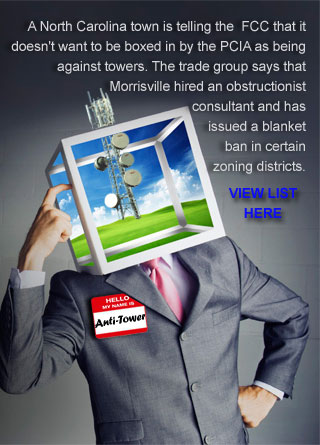 anti-siting consultants. anti-siting consultants.
PCIA's bias list was published in response to the FCC's solicitation for input about progress toward improving Americans' access to broadband service.
The trade group said that the list was not exhaustive, but was provided to highlight some examples of the challenges that face the wireless infrastructure industry every day.
Over 600 communities that retain consultants, identified by the industry as obstructionists, are named in the report.
Morrisville officials reviewed the PCIA complaints on Tuesday and said they plan to issue a letter to the FCC denying the allegations.
Mayor Jackie Holcombe said she wanted to set the record straight and was "stunned that their homework wasn't done."
A senior planner said the town does not have an ordinance banning cell phone towers and the only place they are restricted is in the Town Center planned area.
New telecommunication towers are permitted within the Industrial Management district, and wireless antennas that are concealed within a structure are permitted in all zoning districts, according to town documents.
However, in PCIA's document, the association did not identify Morrisville as having an ordinance banning cell phone towers, but stated that it was one of the "jurisdictions that have codified blanket bans across certain zoning districts."
PCIA informed the FCC that wireless consultants are the source of "many of the barriers and prohibitive costs associated with the deployment of wireless facilities," and it was common for consulting firms to charge excessive application fees and impose "superfluous" requirements which will delay the application and review process.
Morrisville made the list of communities having problematic consultants.
Town records indicate that its consultant, CityScape, charges a fixed $4,150 fee for the entire review process and Morrisville does not require an escrow account that wireless applicants must replenish.
CityScape also offers a 72-hour turnaround for review after the application is complete, said town officials.
Although PCIA did not single out Morrisville's fees in its report, it did identify numerous communities that require an application fee of $8,500 along with an escrow amount of $2,500.
A Wake County judge last month upheld Morrisville's decision denying American Tower Corporation a special use permit to build a 175-foot cell tower after the company appealed.
"It is always good to confirm that the town's ordinances and procedures accommodate the desires of the residents and they stand the test of legal challenge," said Town Manager John Whitson in a statement.
The National Association of Telecommunications Officers and Advisors isn't pleased with PCIA's accusations and has asked its members to contact the FCC to "set the record straight."
NATOA says that those communities that have made the "bad actors" list should refute them by the FCC's reply comments deadline of Sept. 30.
-
|
|
Crown Castle finds a legacy site with upwards of an additional $810,000 price tag
July 14, 2011 - During the hectic cattle car tower buys, mergers and acquisitions during the 1990's to stay ahead of the competition, tower companies would 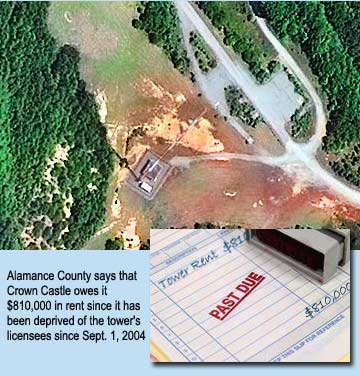 oftentimes find that after they shook out their new portfolios there were some problem sites - even some that were non-existent or were no more than a few section legs on the ground covered by kudzo. oftentimes find that after they shook out their new portfolios there were some problem sites - even some that were non-existent or were no more than a few section legs on the ground covered by kudzo.
When Pinnacle Holdings acquired Motorola's antenna site business in 1999 they later discovered a number of overloaded structures and disconcerting agreements.
After emerging from bankruptcy in 2002 and changing its name to Global Signal, the company maintained a portfolio of approximately 3,300 structures.
In 2005, Global Signal bought 6,700 communications towers from Sprint. Then during January of 2007 Crown Castle International closed on a deal to acquire Global Signal for $5.8 billion.
Crown's attorneys and administrators combed through the thousands of lease and tenant agreements and brought them into compliance.
But one agreement was apparently overlooked and Alamance County, NC now claims it is owed at least $810,000 that it's been deprived of during the past 81 months.
The county filed a lawsuit in U.S. District Court in Greensboro on May 18 against Crown Castle and the tower owner's licensees. However, according to County Attorney Clyde Albright, they would prefer for Crown to make a settlement offer.
The lawsuit stems from the county’s claim that the Crown has been leasing antenna space on the 485-foot guyed tower at the Alamance County landfill in Swepsonville since Sept. 1, 2004 without consent or authority of the county.
The county is also requesting that it wants Crown Castle and Pinnacle Towers - a subsidiary of Crown Castle - to provide the county with contracts of the tower’s licensees since Sept. 1, 2004 to further assess the payments they're entitled to.
In a July 5 letter sent to Raleigh attorney James Thornton, who is representing Crown Castle, Albright said, “I welcome any attempt to reach a mutually beneficial settlement. While there are many points where we disagree, one point which I believe we both agree is that the county controls the future of the tower. If Crown Castle is interested in this future, then a settlement must be reached.”
Albright indentified in his correspondence that the county tried to reach a compromise with Crown Castle before the lawsuit was filed.
“Those discussions were not fruitful by Crown Castle’s refusal to make a realistic offer on the issue of payments received from cell phone companies locating antennas on the tower,” Albright said in his letter.
“Since your client has all of the records indicating the amounts received from the cell phone companies at this location, I would suggest that Crown Castle make an offer to Alamance County that I can take to my Board for consideration. Should Crown Castle desire to manage the tower, please include in your client’s offer a management agreement for consideration by the Alamance County Board of Commissioners,” Albright wrote.
Alamance County entered into a 15-year leasing agreement which had Motorola constructing the tower which was completed September 18, 1989.
The lease of the tower expired on Sept. 1, 2004. There was a renewal option in the contract, but Motorola opted not to renew the lease.
During June 1999, Pinnacle Towers acquired some use of the radio tower from Motorola and began leasing antenna space, according to the lawsuit. Then on Sept. 9, 1999, Pinnacle Towers sought and obtained a transfer of the interest of Motorola in real property from the Alamance County Board of Commissioners. This transfer of interest in real estate was done under seal at the Alamance County Register of Deeds.
According to the lawsuit, Crown Castle then acquired some use of the radio tower from Pinnacle Towers on April 4, 2006, which was 20 months after the Sept. 1, 2004 expiration of Pinnacle Towers’ interest in the radio tower. Pinnacle did not seek to extend the lease on the termination date.
The lawsuit states that the defendants didn’t attempt to negotiate any renewal or extension of the contract or seek written approval from the county commissioners to continue to subcontract for the lease of antenna space on the property as required by state law.
County commissioners weren't aware that they should have been receiving payments from Crown Castle and on March 11 - six and one-half years after the agreement expired, they're looking to recoup over $800,000 after they were alerted that tenants on the structure were paying the nation's largest tower owner in the U.S.
-
|
|
U.S. Senate bill could block local control of collocations on towers
June 27, 2011 - A bill designed to improve public safety communications and provide for a nationwide public safety wireless network is being used by the wireless industry to undermine state and local zoning authorities, according to the U.S. Conference of Mayors and the National Association  of Telecommunications Officers and Advisors. of Telecommunications Officers and Advisors.
Earlier this month, the Senate Committee on Commerce, Science & Transportation voted 21 to 4 and approved the appropriately named S. 911, the Public Safety Spectrum and Wireless Innovation Act, which now moves to the full Senate for a vote.
The bill, sponsored by Senate Commerce Committee Chairman John D. (Jay) Rockefeller IV (D-W.Va.) and Ranking Member Kay Bailey Hutchison (R-Tex.), was applauded by NATOA, however, they said they were greatly concerned with Section 528, which would essentially negate state and local government authority over wireless collocation applications.
The bill's broad language - "...a State or local government may not deny, and shall approve, any eligible facilities request for a modification of an existing wireless tower that does not substantially change the physical dimensions of such tower" - is too vague say industry insiders and could possibly work against zoning authorities.
NATOA also said that it could expose localities to an increased risk and cost of litigation.
The organization believes that Section 528 appears to mandate the automatic approval of new equipment that, while not altering the physical dimensions of the tower, results in increased RF emissions that could cause the site to violate federal standards.
"Also, enactment of the provision could lead to situations where a site was initially approved because it was camouflaged, but due to a change in equipment - that does not substantially change the physical dimensions of the tower - becomes much more visible," NATOA said.
Members of the U.S. Conference of Mayors have concerns as to what would constitute a "substantial" change.
A number of tower site developers have said that - if passed as written - the bill would allow them to perform a drop and swap or provide a larger retrofit to accommodate additional collocations.
“I strongly encourage my colleagues in the House to also move forward with this legislation so that we can sign it into law by September, the 10th anniversary of the 9/11 terrorist attacks," Rockefeller said following his committee's approval.
Key Provisions of S.911, the Public Safety Spectrum and Wireless Innovation Act are:
• Establish a framework for the deployment of a nationwide, interoperable, wireless broadband network for public safety.
• Allocate 10 megahertz of spectrum to public safety.
• Direct the FCC to establish standards that allow public safety officials, when not using the network, to lease capacity on a secondary, but preemptible basis to non-public safety entities.
• Provide the FCC with incentive auction authority, which allows existing spectrum licensees to voluntarily relinquish their airwaves in exchange for a portion of the proceeds of the commercial auction of their spectrum. This provides new incentives for efficient use of spectrum. In addition, the funds from these incentive auctions, in conjunction with funds from the auction of other specified spectrum bands, and funds earned from leasing the public safety network on a secondary basis, will be used to fund the construction and maintenance of the nationwide, interoperable, wireless broadband public safety network.
• Direct the National Science Foundation and the National Institute of Standards and Technology to conduct cutting edge research into transformative wireless technologies.
• Direct surplus revenue from spectrum auctions, estimated to be more than $10 billion, to the U.S. Treasury for deficit reduction.
-
|
|
Sex enters a community's tower siting fray
April 15, 2011 - Bloomfield, N.J., the birthplace of Connie Francis who is well known for her 1960's hit single, Where the Boys Are, will now be celebrated as the  community that exposed premarital sex between cell towers, no matter whether they're boys, girls or disguised as cross dressing faux conifers. community that exposed premarital sex between cell towers, no matter whether they're boys, girls or disguised as cross dressing faux conifers.
According to Bloomfield Life writer Jeff Frankel, attorneys argued over the proposed merger of AT&T and T-Mobile and how it could affect a proposed cell site in the township at last night's three hour zoning board meeting.
A proposed cell phone tower at the Brookside Garden Center has been at the center of controversy for months.
The two companies are "married" after making the merger public, said Jack Dusinberre, an attorney hired by a neighboring business of the Brookside Garden Center. The merger may mean the yet-to-be-approved cell tower is no longer necessary, he said.
"We can't ignore that," said Dusinberre. "They're in bed already, subject to government approval."
But the two cell carriers and their towers are merely "engaged, but not married yet," countered James Pryor, an attorney hired by T-Mobile. There may be stipulations set by the federal government that would not influence cell phone reception, Pryor said.
"So they're not having sex?" Dusinberre shot back, said Frankel.
A radio frequency engineer on behalf of T-Mobile, testified the 120-foot flagpole would fill in service gaps, but the township's RF engineer took him to task for using outdated coverage maps.
During the public session a township resident voiced his concern about the pole's location, stating, "Towers do fall." He didn't take the opportunity to explore whether they can also fall in love.
Presentations are expected to continue at the board's May 12 meeting.
Both the Federal Communications Commission and Department of Justice must sign off on the AT&T and T-Mobile marriage, which has drawn concern from politicians and some interest groups.
The FCC issued a public notice on its web site yesterday and held a press conference.
-
|
|
Tower "buyer beware" is county's defense for
non-existent structure
March 7, 2011 - An attorney for Fayette County, Pa. says a tower on a parcel of property it sold wasn't a stealth structure, it just wasn't there; so there, that should do it.
 Or so says attorney Marie Milie Jones who wants a federal judge to dismiss a lawsuit claiming a tax sale ad falsely said a piece of property has a cell phone tower on it. Or so says attorney Marie Milie Jones who wants a federal judge to dismiss a lawsuit claiming a tax sale ad falsely said a piece of property has a cell phone tower on it.
Arguing for the county's insurance company, Jones said that the doctrine of caveat emptor - "let the buyer beware" - takes precedence over the county saying that the property did indeed have a tower on it even if didn't.
WRH Realty LLC sued the county, its tax claim bureau and director Sarah Thomas last year in federal court.
The suit claimed the company was deceived into believing that property purchased in Lower Tyrone Township two years ago had a cell phone tower on it when it did not.
The realty firm wants the county to repay $6,250 the company paid for the property, and related costs and damages.
The former property owner did have a lease agreement with a cell phone company, but the tower was never built. Nevertheless, the real estate firm claims the county advertised the property as having a tower, thus duping the firm into buying it at a tax sale.
"The doctrine of 'caveat emptor' governs sales conducted under Pennsylvania's Real Estate Tax Sales Law, and this action is not an appropriate remedy for a purchaser of property following confirmation of such sale," Jones wrote in a motion to dismiss the suit filed last week.
-
|
 |
|